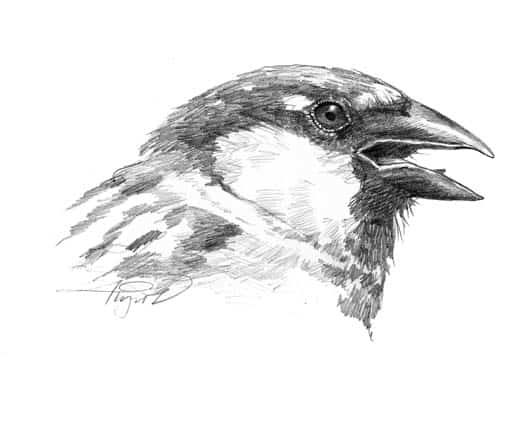By Elise Tillinghast
House sparrows—those little brown and gray birds that flash mob the bird feeder—are common and easy to see. They’re quarrelsome, noisy, and when they’re on the ground, they move in vigorous hops that remind me of popcorn popping out of a pan.
They’re also an invasive species, scavengers that have hitched their wagons to humans and, at least on this continent, are having a very successful ride. Our farms, lawns, and grocery store parking lots provide all kinds of year-round foraging for these birds, and our structures provide them shelter. From gutter pipes to the bulb rims of traffic lights, house sparrows know how to make themselves at home in human-dominated settings, regardless of whether humans want them there.
Unfortunately, they are a real menace to bluebirds, purple martins, and many other native bird species. They’re extremely aggressive competitors for nesting sites. They destroy eggs, kill chicks, and will peck to death adult birds. Adding insult to death, they have even been known to build their own nests on top of their victims’ corpses.
This behavior isn’t pretty, but as the bird world goes, it’s hardly unique in its villainy. Cute little house wrens, for example, will sometimes destroy other birds’ eggs and young. House sparrows are reviled because there are just so many of them, and the frequency of their crimes is overwhelming. They’re prolific breeders, and this time of year they’re already preparing for next summer’s broods.
House sparrows are highly social birds that return repeatedly to the same hierarchically-organized flock in order to forage and roost. From August into September, you’re likely to see them massed together, looking especially scruffy as they go through their post-breeding molt.
By October, new feathers have formed, hormones are on the rise, and courting behaviors begin. The most obvious sign of this transition is the gradual darkening of the male bird’s beak color, which turns from yellow and gray to uniform black in winter. The male’s black chest badge may also serve as a courtship display, and studies suggest that its size roughly correlates to status in the flock. The bigger the badge, the more a male is likely to be a dominant bird with multiple mates. Male courting behaviors including intensive chirping at females, and rapid vibration of lowered wings.
By November, some house sparrows have established mate bonds. They may visit nesting sites from previous years or stake out new sites. Courtship behaviors simmer down with the colder temperatures, but erupt in warm spells throughout the winter, and hormones continue to build. By the time favorable weather for nesting arrives, well before many of our migratory songbirds return, there will already be house sparrow couples committed to nesting sites and primed to breed. Others will pair off during the spring breeding season.
A sparrow pair can produce multiple broods in one year. The number of broods, and recovery intervals between them, is dependent in part on environmental factors. Ironically, nest boxes, which many of us put up to support the recovery of bluebird populations, are ideal sites for you-know-who.
If you’d prefer not to shelter these birds, understanding their winter courtship behavior is a good first step. If you see them around your home this winter, consider boarding up nest boxes until early spring, so they won’t develop an early attachment to these nesting sites (although this does mean less cold weather shelter for other wildlife). To be guaranteed sparrow-free, however, there’s no avoiding the hassle of monitoring boxes throughout the breeding season.
Elise Tillinghast is executive director/publisher of Northern Woodlands magazine. The illustration for this column was drawn by Adelaide Tyrol. The Outside Story is assigned and edited by Northern Woodlands magazine, and sponsored by the Wellborn Ecology Fund of New Hampshire Charitable Foundation: wellborn@nhcf.org. A book compilation of Outside Story articles is available at https://www.northernwoodlands.org.
House sparrows in winter, scavengers that have hitch onto humans for survival




